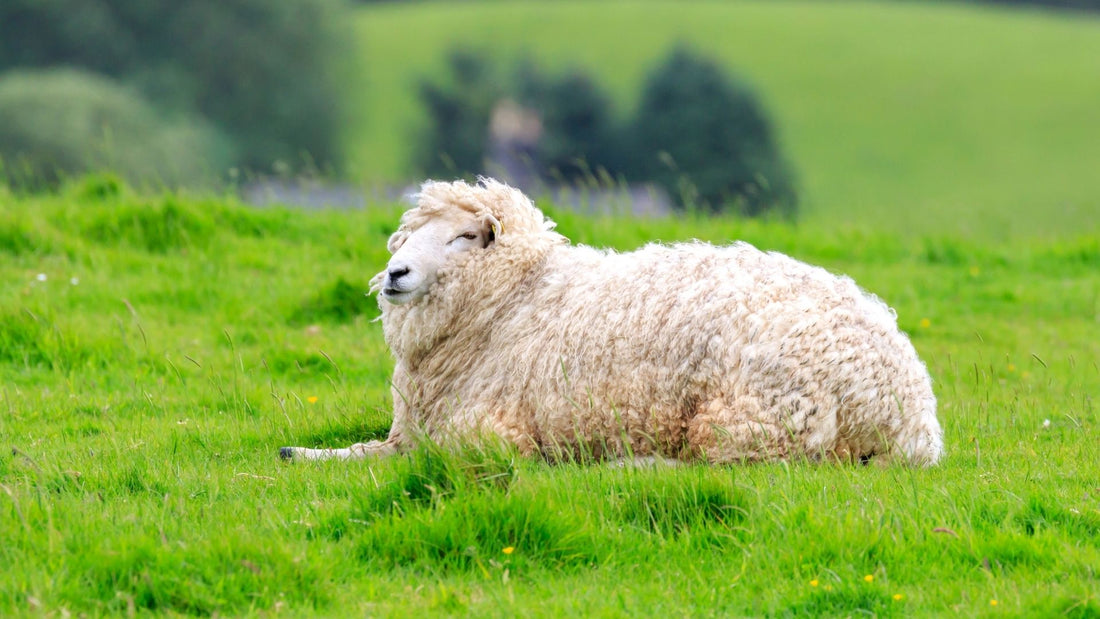
The Complete Guide to Fly Strike in Sheep
Share
This guide aims to provide comprehensive information for lifestyle farmers on understanding, identifying, safely preventing, and managing fly strike in your sheep, ensuring the welfare and productivity of your flock.
Contents:
- What is fly strike
- What are the signs of fly strike
- Why do sheep get fly strike
- How to reduce the chances of fly strike
- What is the best fly strike preventative
- What is the best fly strike treatment
- What about chemical pour-ons
- Can sheep be shorn after applying a pour-on
- Do I use chemical pour-ons on my sheep
- What to do if you have a sheep that has fly strike
What is fly strike?
Fly strike, also known as myiasis, is a common and potentially deadly condition in sheep caused by the infestation of fly larvae (maggots) on the sheep's skin or in its wounds.
Flies such as the blowfly are attracted to soiled or moist areas on the sheep, where they lay their eggs. These eggs hatch into larvae, which then feed on the sheep's flesh and can cause severe tissue damage and even death if left untreated.
What are the signs of fly strike?
Identifying fly strike early is crucial for effective treatment. Signs of fly strike in sheep may include:
Agitation, twitching and restlessness: Fly-struck sheep may become agitated, and separate themselves from the flock constantly moving or rubbing themselves against objects.
Loss of appetite: Sheep may exhibit a decreased appetite or show signs of discomfort while eating.
Lethargy: Infested sheep may appear weak, lethargic, or unwilling to move.
Wet patches of wool: Sheep with fly strike often exhibit wet or matted wool in the affected areas. This occurs because the presence of maggots and their feeding activity can cause the release of fluids, such as blood and serum, from the damaged tissue. Additionally, the wool may become damp or wet due to the moisture present in the infested area, which can result from urine or feceal matter accumulating on the sheep's skin.
Foul odour: A strong, unpleasant smell often accompanies fly strike due to the presence of decaying flesh.
Visible maggots: Maggots may be seen on the sheep's skin, particularly around the tail, breech, or other soiled areas.
Open wounds or sores: When left untreated infested areas may have open wounds, sores, or moist, matted wool where flies can lay eggs.
Why do sheep get fly strike?
Several factors contribute to the development of fly strike in sheep:
Warm and humid conditions: Flies thrive in warm, moist environments, making sheep susceptible to fly strike during the spring and summer months. Particularly after heavy rain followed by hot temperatures.
Poor hygiene: Sheep with dirty, soiled wool are at greater risk of attracting flies, as the moisture and organic matter provide an ideal breeding ground for fly larvae.
Wounds or injuries: Open wounds on a sheep's skin in areas out of ths sun can attract flies, which lay eggs in these areas. This includes wounds from shearing, docking, or injuries caused by fighting or predator attacks.
Excessive wool: Sheep with excessive wool growth, particularly around the tail and breech, are more prone to fly strike as the wool can become matted with faeces and urine, creating an environment conducive to fly infestation. Long tails increase a sheep's chances of fly strike greatly due to more faeces and moisture around the backend of the sheep.
Lack of parasite control: Failure to implement effective parasite control measures, such as timely worming, increases the risk of fly strike.
Overcrowding: Overcrowded conditions can lead to increased stress and competition among sheep, making them more susceptible to fly strike.
Poor nutrition: Malnourished or underfed sheep may have weakened immune systems, making them more vulnerable to fly strike.
Overfeeding: Overweight sheep are extremely prone to fly strike. Particularly when they get folds in their skin which provide the optimal environment for fly strike.
Presence of other animals: The presence of other animals can attract flies to the area, increasing the risk of fly strike in sheep.
How to reduce the chances of fly strike
- Grazing sheep in paddocks away from dense bush
- Grazing sheep in paddocks exposed to the wind
- Crutch your sheep if they get any dags around the breech
- Shear your sheep twice over the warmer months of the year
- Rotational grazing to minimise build-up of faecal matter (don’t overgraze)
- Monitor your flock regularly (daily after rainfall in humid conditions)
- Remove any wool around an area you suspect to be affected at first site (get yourself a set of hand shears or clippers to do this quickly and easily)
- Flies like to lay their eggs on decaying matter - keeping your sheep at their optimal health and hygiene reduces the risk of fly strike greatly.
What is the best fly strike preventative?
Shearing your sheep twice over the warmer months is the best fly strike preventative.
Flies require warmth, moisture, and darkness (shelter from sunlight) to support the survival of their eggs and maggots, conditions readily provided by long wool on sheep during warmer months.
Once a sheep is shorn, its skin becomes significantly drier and thicker due to direct exposure to sunlight. If flies lay eggs or maggots on a shorn sheep, the sunlight effectively kills them, preventing the establishment of an infestation.

What is the best fly strike treatment?
In addition to fully shearing any affected sheep, Stockholm Tar (derived from the resin of pine trees) is hands down the best treatment for fly strike I have seen (other than shearing your sheep).

This is for several reasons:
- It legitimately repels flies from sheep making it a valuable tool in fly strike prevention as well as a treatment. Most commonly applied around the horns of sheep, Stockholm tar acts as a powerful deterrent, particularly in areas highly prone to fly strike.
- Stockholm tar possesses natural antiseptic properties, aiding in the healing process of any areas of fly strike including existing wounds or abrasions on the sheep's skin.
- Stockholm Tar has been used successfully for decades
- It’s affordable to use
- It's safe to use
What about chemical pour-ons?
It is extremely important to do thorough research before using any pour-on.
Chemical pour-ons such as commonly used Zapp Encore contain active ingredients that include insecticides which work by disrupting the nervous system of flies and those which hatch from eggs, leading to paralysis and death.
It also effects the nervous system of the sheep its applied to and any human it comes in contact with. I personally know a shearer who became unconscious and was hospitalised after being exposed to Zapp.

Zapp Encore is considerably more toxic than most users realise and should be used with extreme care. Zapp requires a meat withholding period of 56 days. This is particularly concerning if you farm sheep for the freezer.
Additionally, some products contain insect growth regulators (IGRs) that prevent fly eggs from developing into maggots.
The most dangerous of all (Maggo) contains organophosphates which are human carcinogens, causing cancer and organ damage with repeat exposure.

Can sheep be shorn after applying a pour-on?
No.
You must adhere to the wool withholding periods listed on the pour-on you use.
Almost all have a minimum wool withholding period of 2 months. This means that after application your sheep cannot be safely shorn for 2 months. Therefore you have to plan ahead of time when using pour-ons.
If your vet is going to use a pour-on to treat fly strike on your sheep (even if it is just a spot treatment) the vet or a shearer must shear the sheep completely first.
Once a chemical pour-on has been used (even if it is just a spot treatment) it will be 2 months minimum before the sheep can be safely shorn.
There are a lot of misconceptions about spot treating and still being able to shear the sheep afterwards. Chemical pour-ons may state that sheep are safe to shear if they have been spot-treated, however, this incorrect.
When shearing a sheep it is impossible for your clothing, skin and equipment not to come in contact with a pour-on that has been applied (even if it is just a spot treatment).
The residues of these chemicals persist on the sheep's skin for a prolonged duration. During shearing...
- Remnants are inhaled as dust from the friction of the comb and cutter.
- Remnants contaminate the shearer's clothing, equipment, and skin.
- Contaminated clothing causes the family washing machine to become contaminated.
Do I use chemical pour-ons on my sheep?
Considering the risks of toxicity to both sheep and humans I personally never use pour-ons on my sheep.
I simply shear my sheep twice over the warmer months which is a more effective preventative measure than using pour-ons.
What to do if you have a sheep that has fly strike
- Step 1: Immediately seperate it from the flock.
- Step 2: Remove all of the wool from the affected and surrounding area so that sunlight can get in to the skin.
- Step 3: If you are unable to remove the wool, apply a Salt Water Solution (pool salt or any non-iodised salt) to the affected area. 1/4 cup of salt to 1 litre of water.
- Step 4: Organise a shearer to completely shear the sheep organise a shearer to come and do a full shear.
- Step 5: Once the sheep is fully shorn and if needed apply Stockholm Tar.
In most cases just shearing the sheep is effective, if you have caught the fly strike early enough, and the skin isn't broken.
Why salt water works
- Dehydration of Maggots: Salt water works by creating a hypertonic environment, which draws moisture out of the maggots' bodies, leading to their dehydration and eventual death. This helps to eliminate the parasites without the need for harsh chemicals.
- Antiseptic Properties: Salt is a natural antiseptic. When dissolved in water, it creates a saline solution that helps to disinfect wounds by killing bacteria and other pathogens. This reduces the risk of secondary infections in the affected area.
- Wound Cleaning: The salt water helps to clean out debris, dead tissue, and maggot waste from the wound, promoting better healing conditions.
- Promotes Healing: Salt water helps to reduce swelling and inflammation around the affected area, aiding in the natural healing process of the skin and tissue.
In Summary
Fly strike poses a significant threat to sheep welfare and productivity. It can be extremely frustrating to deal with, and can easily spread through your flock if you don't take action quickly.
By understanding the signs and the benefits of regularly shearing your sheep, you can easily manage fly strike and ensure the well-being of your flock.
Proactive shearing practices, regular monitoring, and prompt action are essential for successful stress-free fly strike control.
